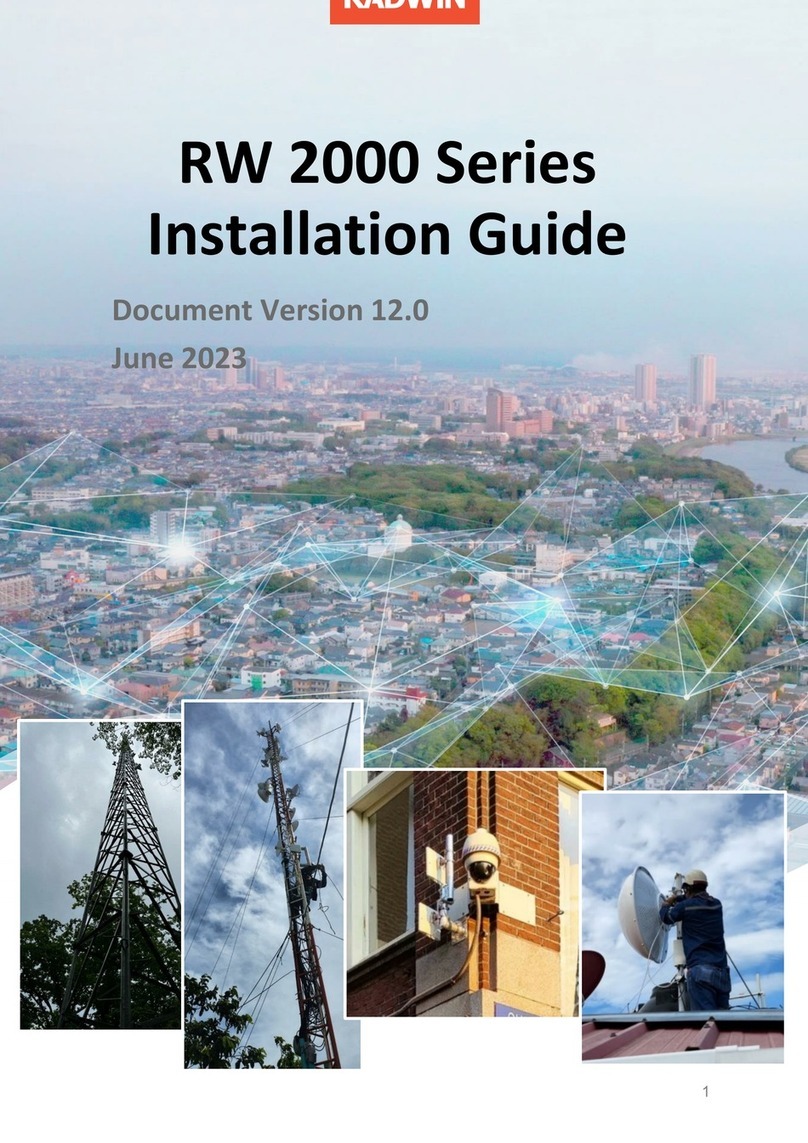RADWIN 5000 SCB Jet User Manual Release 4.2 ii
8.3 Advanced Link Configuration ............................................................................................8-17
8.4 Logging on to the RT-B(HSU) Over the Air......................................................................... 8-25
8.5 Bulk Software Backup........................................................................................................8-25
8.6 Configuration with Telnet (Non-Secured and SSH) ...........................................................8-25
Chapter 9: Site Configuration
9.1 Site Tool Bar ........................................................................................................................9-1
9.2 Site Configuration Window .................................................................................................9-2
9.3 Configuration Tabs ..............................................................................................................9-3
9.4 Deactivate RT-A(HBS) ........................................................................................................9-28
9.5 Electronic Antenna Alignment for Unregistered RT-B(HSU) .............................................9-28
9.6 Deregister RT-B(HSU) ........................................................................................................9-30
9.7 Suspend a Deregistered RT-B(HSU)...................................................................................9-30
9.8 Reset the ODU...................................................................................................................9-30
Chapter 10: PtP: Monitoring and Diagnostics
10.1 Retrieving Link Information.............................................................................................10-1
10.2 Throughput Checking ......................................................................................................10-3
10.3 Recent Events..................................................................................................................10-5
10.4 Performance Monitoring.................................................................................................10-6
10.5 Manager Traps ..............................................................................................................10-10
10.6 Active Alarms.................................................................................................................10-11
10.7 Other Diagnostic Aids....................................................................................................10-12
Chapter 11: PtP: Using the Web Interface
11.1 What is it For ...................................................................................................................11-1
11.2 What it Cannot Do...........................................................................................................11-1
11.3 Preparations Before You Start.........................................................................................11-2
11.4 Logging on .......................................................................................................................11-2
11.5 Site Management - Master ODU .....................................................................................11-3
11.6 Site Management - Slave ODU ........................................................................................11-9
Part 3: PtMP Sector Configuration and Management
Chapter 12: Sector Main Window
12.1 What we will do here ...................................................................................................... 12-1
12.2 Looking at a pre-configured Sector .................................................................................12-1
12.3 Four Sector Display Views ............................................................................................... 12-3
12.4 Continuing with our Example Sector............................................................................. 12-10
12.5 Exploring the RADWIN Manager Main Window - HBS .................................................. 12-11
12.6 Exploring the RADWIN Manager Main Window - HSU..................................................12-22
12.7 Logging on to a HSU ......................................................................................................12-22
12.8 Setting RADWIN Manager Preferences.........................................................................12-26
12.9 What Comes Next?........................................................................................................12-26
Chapter 13: Installing the Sector
13.1 Sector Configuration Workflow.......................................................................................13-1
13.2 Scope of this Chapter ......................................................................................................13-1
13.3 Concepts..........................................................................................................................13-2
13.4 Workflow.........................................................................................................................13-2
13.5 Default RADWIN 5000 SCB Jet PtMP Settings ................................................................. 13-3
13.6 Configuring the Sector out of the Box - IP Addresses .....................................................13-6
13.7 The Initial RADWIN Manager Main Window................................................................... 13-7
13.8 Configuring an HSU From the HBS ................................................................................13-17
13.9 Registering an HSU for service ...................................................................................... 13-21
13.10 Deactivating the HBS...................................................................................................13-26
13.11 Deregistering an HSU ..................................................................................................13-27




























